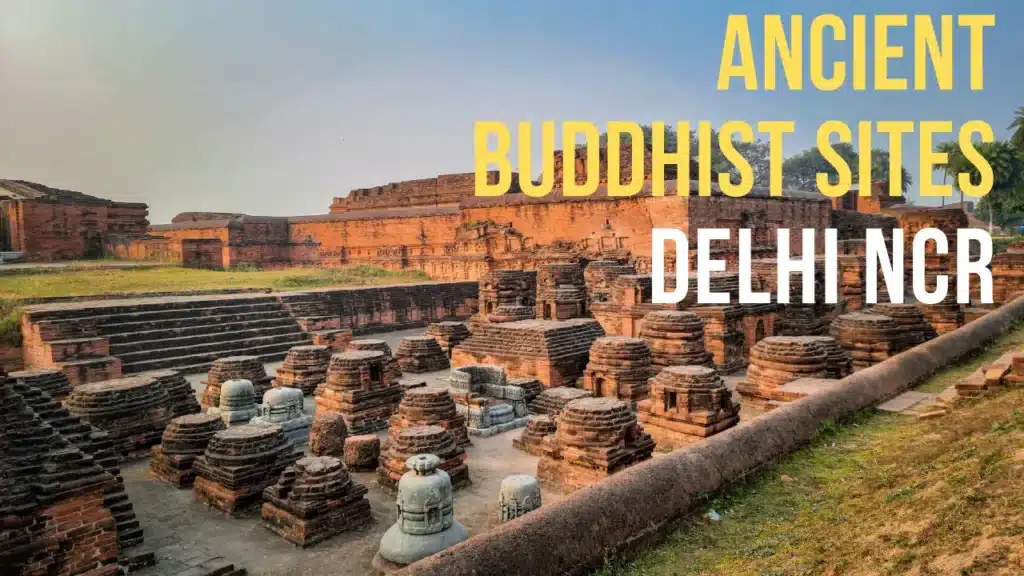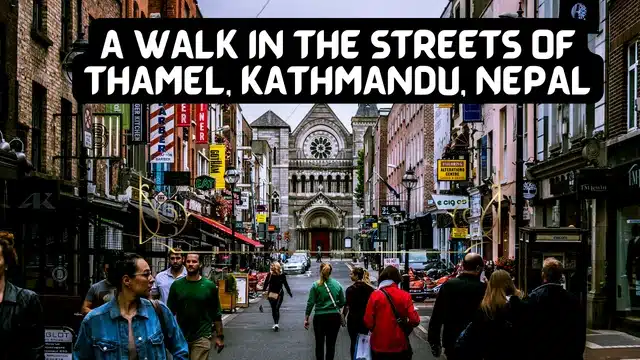The bustling metropolis of Delhi and its surrounding National Capital Region (NCR) might not immediately conjure images of ancient Buddhist sites, unlike regions such as Bihar, Uttar Pradesh and Maharashtra. However, hidden beneath layers of continuous habitation and successive imperial capitals lies a subtle yet significant Buddhist heritage. From the time of Emperor Ashoka’s widespread propagation of the Dharma to the subtle influences that persisted through various dynasties, Delhi and its environs played a role in the narrative of Buddhism in India. While grand monastic complexes comparable to those found elsewhere are rare, the area offers intriguing archaeological clues and historical mentions that point to a distinct Buddhist presence in antiquity.
This article explores the traces of ancient Buddhist sites in Delhi and the NCR, highlighting the historical context of their existence, the challenges in identifying them, and the archaeological evidence that sheds light on this often-overlooked aspect of the region’s past.
Ancient Buddhist Sites in Delhi and NCR Area of India
The region encompassing modern Delhi and the NCR has been a continuously inhabited area for millennia, with successive cities built upon the remains of their predecessors. This urban layering, combined with later religious and political shifts, has made the identification and preservation of ancient Buddhist sites particularly challenging. However, historical records and limited archaeological findings provide intriguing glimpses into this forgotten era.
Ashokan Pillars (Feroz Shah Kotla and Ridge Area, Delhi)
Two prominent Ashokan pillars were originally erected elsewhere but were later relocated to Delhi by Sultan Firoz Shah Tughlaq in the 14th century.
Feroz Shah Kotla (Delhi Gate area)
This pillar, originally from Topra Kalan in Haryana’s Yamunanagar district, stands within the ruins of Firoz Shah Kotla fort. It is a sandstone monolithic column, approximately 13 meters high, bearing Ashokan Edicts (Pillar Edict VII). These edicts convey Ashoka’s messages of Dharma, peace, and righteous governance, clearly demonstrating his commitment to the spread of Buddhism.
Ridge Area (near Hindu Rao Hospital, North Delhi)
This pillar, originally from Meerut in Uttar Pradesh, now stands on the Delhi Ridge. It also contains Ashokan edicts, albeit less complete than the Topra pillar.
History and Significance
The very act of Emperor Ashoka erecting these massive pillars with Buddhist teachings indicates the importance he attached to this region (or the areas from which they were brought) as part of his vast empire and his mission to propagate the Dharma. While the pillars were moved, their existence in the vicinity and their original locations suggest that Buddhism was a living faith in the broader region. The transportation of these pillars centuries later by Firoz Shah Tughlaq also highlights their symbolic importance even to later rulers, perhaps seen as markers of imperial power.
Reasons for Destruction/ Decline (Original Sites) & Relocation
The original Buddhist structures or associated monasteries at Topra and Meerut would have suffered from the general decline of Buddhism in North India due to Huna invasions, changing royal patronage, and the resurgence of other faiths.
Firoz Shah Tughlaq’s motive for moving the pillars was likely a blend of curiosity, a desire to acquire impressive monuments for his new capital, and perhaps a symbol of his power over previous eras.
How to Reach
Both pillars are publicly accessible. The Feroz Shah Kotla pillar is within the Feroz Shah Kotla fort complex, and the Ridge pillar is near Hindu Rao Hospital in North Delhi.
Indraprastha / Purana Qila (Old Fort Area, Delhi)
The site of Purana Qila in central Delhi is historically associated with the legendary city of Indraprastha.
History and Significance
While famously associated with the Mahabharata, ancient Buddhist texts also refer to Indraprastha (or Indapatta/Indapattana) as the capital of the Kuru Kingdom and a significant city during the Buddha’s time. Some Buddhist traditions even suggest that the Buddha’s razor and needle were enshrined at Indapatta. Archaeological excavations at Purana Qila have revealed layers of continuous habitation from the Painted Grey Ware period (associated with the Mahabharata era, c. 1200-800 BCE) through Mauryan, Sunga, Kushana, Gupta, and later periods. While no large-scale Buddhist monasteries or stupas have been unearthed that would match the grandeur of descriptions of major Buddhist centers, the presence of Mauryan-era artifacts and the historical mention in Buddhist literature strongly suggest that Buddhism would have been present and practiced in this ancient city. The region’s strategic location on ancient trade routes (the Uttarapatha) would have facilitated the movement of monks and ideas.
Why it was Destroyed/Declined
Continuous Rebuilding
Delhi has been built and rebuilt numerous times. Each new city and dynasty used materials from previous structures, often burying or dismantling earlier buildings.
Lack of Direct Patronage
While Buddhism was present, Delhi may not have been a primary center of royal Buddhist patronage like Pataliputra or Sarnath.
Later Invasions and Religious Shifts
The arrival of various invading forces (Hunas, Turks) and the rise of other religious traditions over centuries led to the decline and eventual disappearance of overt Buddhist institutions.
How to Reach
Purana Qila is a major tourist attraction in Delhi, easily accessible by public transport (metro, bus, auto-rickshaw). The archaeological museum at Purana Qila displays some of the excavated artifacts.
Agroha (Hisar District, Haryana – Part of NCR Influence Zone)
While geographically in Haryana (Hisar district), Agroha falls within the broader historical and cultural influence zone of the Delhi NCR, being on an ancient trade route connecting to the capital region.
History and Significance
The city of Agroha was strategically located on the ancient trade route connecting Taxila (now in Pakistan) and Mathura, which established it as a significant hub for trade and political affairs. Agroha maintained its prominence until the new township of Hisar-e-Firoza (modern-day Hisar) was founded by Firoz Shah Tughlaq.
The site of Agroha has undergone multiple archaeological excavations. The earliest was conducted by C.J. Rodgers in 1888-89, followed by a re-excavation by H.L. Srivastava of the Archaeological Survey of India in 1938-39, reaching a depth of approximately 3.65 meters. Subsequent excavations were carried out from 1978 to 1984 by P.K. Sharan and J.S. Khatri from the Department of Archaeology & Museums, Government of Haryana.
A coin hoard discovered at the site provided valuable insights into the city’s history, containing four Indo-Greek coins, one punch-marked coin, and 51 coins from the Agrodaka Republic. The discovery of these Agreya Janapada coins, coupled with its ancient name “Agrodaka” found in historical literature, confirms that Agroha was the capital of a republic.
Archaeological Findings
Archaeological digs at Agroha have revealed the remains of a fortified town that was continuously inhabited from the 4th century BCE to the 14th century CE. The excavations uncovered residential and community buildings constructed from baked bricks. A notable discovery was the presence of a Buddhist stupa and a Hindu temple built side-by-side, suggesting a long history of communal harmony and co-existence in the city. The stupa-like structure suggests a monastic complex, further indicating a settled Buddhist community.
How to Reach Agroha
Agroha is accessible by road from Hisar, which is well-connected to Delhi by road and rail. Distance from New Delhi is 220 km approx and may take 4 hours only.
Possible Indications in Other NCR Areas
While specific major Buddhist sites in other parts of the NCR (like Ghaziabad, Noida, Faridabad, Gurugram) are not as clearly identified archaeologically as those mentioned above, the historical context strongly suggests a scattered Buddhist presence:
Trade Routes
The entire NCR region was criss-crossed by ancient trade routes that linked major Buddhist centers like Mathura (to the south), Kurukshetra/Thanesar (to the north), and ultimately the Gandhara region. Monks and traders would have used these routes, leading to the establishment of smaller viharas or resting places.
Mauryan and Kushan Influence
Both the Mauryan (Ashoka) and Kushan empires had significant Buddhist patronage and controlled this region. It’s highly probable that minor stupas or viharas existed to cater to local communities or travelling monks.
Terracotta and Pottery Findings
Chance finds of Buddhist-themed terracottas or distinctive pottery from the early historical period in various parts of the NCR could indicate localized Buddhist presence, even if formal structures haven’t been identified.
Challenges in Identifying Ancient Buddhist Sites in Delhi/NCR
Continuous Urbanization
Unlike remote archaeological sites, Delhi and its NCR have been continuously inhabited for millennia. Successive layers of construction have buried or destroyed earlier structures, whether it is ancient Hindu or Buddhist sites..
Lack of Monumental Remains
Many early Buddhist structures, especially in less prominent centers, were made of brick, wood, or mud, which are less durable than stone and thus less likely to survive centuries of neglect or re-use of materials.
You Might be Interested in – Kashi – Spiritual Haven for Seekers and Believers Alike
Limited Deep Excavations
Due to dense population and existing infrastructure, large-scale deep archaeological excavations are often difficult and expensive to undertake.
Emphasis on Later Periods
Much of Delhi’s preserved archaeological heritage focuses on the Sultanate, Mughal, and British periods, often overshadowing earlier layers.
Conclusion
The ancient Buddhist heritage of Delhi and the NCR, though not marked by the grand monuments of other regions, is subtly woven into its historical fabric. The presence of Ashokan pillars, the ancient literary references to Indraprastha, and the archaeological evidence from Agroha provide compelling proof of Buddhism’s existence and influence in this strategically important area. While continuous urban development and historical transformations have obscured much of this past, these surviving traces invite us to rethink the religious landscape of ancient Delhi. The ongoing work of archaeologists, coupled with a deeper appreciation of historical texts, continues to uncover the whispers of the Dharma, revealing a more diverse and layered spiritual history for India’s capital region.

References, General Overviews & Historical Contexts
Archaeological Survey of India (ASI): ASI is the primary authority for archaeology in India. While direct links to specific reports for every site might require searching their archives, their website is the official portal.
Ancient History of Delhi (Delhi Government website): Provides a general historical overview of Delhi, often touching upon early periods.
Buddhism in Delhi (Academic Articles/General): While specific scholarly articles focusing solely on “Buddhism in Delhi” are less common due to the scarcity of major sites, general histories of Buddhism in North India will include Delhi’s context.
You might find discussions within broader academic works on Mauryan or Kushan periods in North India. Search academic databases (e.g., Jstor, Google Scholar) for terms like “Buddhism Mauryan Delhi,” “Kushan influence Delhi.”
Site-Specific References:
Feroz Shah Kotla (Topra Pillar)
Source: ASI protected monument information for Feroz Shah Kotla.
Source: Texts on Ashokan Edicts.
Link (Wikipedia – Ashoka’s Edicts)
Source: Historical accounts of Firoz Shah Tughlaq’s reign, e.g., Barani’s Tarikh-i-Firoz Shahi.
Link (Britannica – Firoz Shah Tughlaq)
Ridge Area (Meerut Pillar):
Source: ASI protected monument information for the Ridge area pillar.
Link (Wikipedia – Delhi Ridge) (often mentions historical structures)
Source: Historical accounts of Firoz Shah Tughlaq’s acquisition of the Meerut pillar.
Indraprastha / Purana Qila (Old Fort Area, Delhi):
Source: ASI excavation reports for Purana Qila. These are often published in Indian Archaeology – A Review (a yearly ASI publication). Finding a direct public link to the full report online can be challenging without institutional access, but summary information is usually available.
Link (Wikipedia – Purana Qila) (provides good summary and references)
Source: Buddhist canonical texts that mention Indapatta/Indraprastha.
Link (Entry on Indapatta in Buddhist Dictionary) (This provides a reference to its mention in Buddhist texts like the Majjhima Nikaya).
Agroha (Hisar District, Haryana – Part of NCR Influence Zone):
Source: Archaeological reports and academic papers on Agroha, particularly those detailing the co-existence of Buddhist and Hindu structures.
Link (The Tribune India article on Hindu-Buddhist coexistence at Agroha, citing archaeological observations)
Link (Hissar District Official Site – mentions Agroha’s historical significance)




